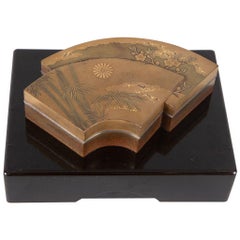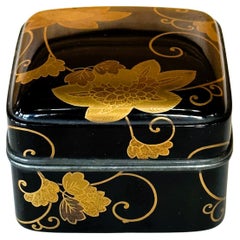Items Similar to Japanese Lacquer Incense Box, Kogo, Momoyama or Edo Period, 16th/17th Century
Want more images or videos?
Request additional images or videos from the seller
1 of 13
Japanese Lacquer Incense Box, Kogo, Momoyama or Edo Period, 16th/17th Century
$6,000
£4,552.66
€5,205.56
CA$8,380.37
A$9,317.83
CHF 4,865.26
MX$113,420.74
NOK 62,078.59
SEK 58,164.67
DKK 38,850.07
Shipping
Retrieving quote...The 1stDibs Promise:
Authenticity Guarantee,
Money-Back Guarantee,
24-Hour Cancellation
About the Item
A wonderful Japanese lacquer incense box, kogo, with a design of plovers in flight, late Momoyama or early Edo Period, circa 1600, Japan.
The small box, called a kogo, was used to store precious incense. Crafted in rich and finely worked maki-e lacquer, the exterior of the kogo decorated with a flock of plovers, chidori, in flight against golden clouds and a gold dusted sky. The interior also with maki-e chidori in flight against a nashiji ground. The rims of the kogo mounted in pewter.
Plovers, known as chidori in Japan, are considered auspicious animals, symbolizing longevity and perseverance. Their call is thought to sound like the word "chiyo", meaning ten thousand generations. Because they often fly over windy or stormy seas, they are seen as being tenacious.
With a later wooden storage box, tomobako, of Japanese cedar, sugi, with a two character inscription "kogo".
Measurements of kogo only: 2.88" x 2.63" x 1.13"
- Dimensions:Height: 2.75 in (6.99 cm)Width: 3.75 in (9.53 cm)Depth: 3.75 in (9.53 cm)
- Style:Edo (Of the Period)
- Materials and Techniques:
- Place of Origin:
- Period:Early 17th Century
- Date of Manufacture:circa 1600
- Condition:Wear consistent with age and use. Minor fading. No chips, cracks or repairs noted. Storage box of a later date.
- Seller Location:Austin, TX
- Reference Number:1stDibs: LU894727671772
About the Seller
5.0
Platinum Seller
Premium sellers with a 4.7+ rating and 24-hour response times
Established in 2001
1stDibs seller since 2010
345 sales on 1stDibs
Typical response time: <1 hour
- ShippingRetrieving quote...Shipping from: Austin, TX
- Return Policy
Authenticity Guarantee
In the unlikely event there’s an issue with an item’s authenticity, contact us within 1 year for a full refund. DetailsMoney-Back Guarantee
If your item is not as described, is damaged in transit, or does not arrive, contact us within 7 days for a full refund. Details24-Hour Cancellation
You have a 24-hour grace period in which to reconsider your purchase, with no questions asked.Vetted Professional Sellers
Our world-class sellers must adhere to strict standards for service and quality, maintaining the integrity of our listings.Price-Match Guarantee
If you find that a seller listed the same item for a lower price elsewhere, we’ll match it.Trusted Global Delivery
Our best-in-class carrier network provides specialized shipping options worldwide, including custom delivery.More From This Seller
View AllJapanese Maki-e Lacquer Document Box, Edo Period, early 19th Century, Japan
Located in Austin, TX
A spectacular Japanese maki-e lacquer lidded box, possibly a writing box, suzuribako, decorated with images of folding fans, ogi, Edo Period, earl...
Category
Antique Early 19th Century Japanese Edo Lacquer
Materials
Coral
Japanese Stacking Incense Box, Ju-Kobako, Meiji Period, Mid 19th century, Japan
Located in Austin, TX
An exquisite small Japanese maki-e lacquer stacking box for incense and accessories, ju-kobako, late Edo or early Meiji Period, mid 19th century, Japan.
Crafted in maki-e lacquer an...
Category
Antique Mid-19th Century Japanese Meiji Lacquer
Materials
Silver
Japanese Lacquer Incense Accessories Box, Kobako, Edo Period, mid 19th c, Japan
Located in Austin, TX
A remarkable Japanese maki-e lacquer box for incense accessories, kobako, with interior fitted tray, kakego, designed with a temple complex scene, late Edo Period, mid 19th century, ...
Category
Antique Mid-19th Century Japanese Edo Lacquer
Materials
Silk, Softwood, Cypress, Lacquer
Japanese Lacquer Writing Box, Suzuribako, Edo Period, 18th Century, Japan
Located in Austin, TX
An exceptionally fine and unusual Japanese lacquer writing implements box, suzuribako, in the form of a zither, koto, Edo Period, 18th century, Japan. With a modern wood storage box,...
Category
Antique 18th Century Japanese Edo Lacquer
Materials
Gold, Silver, Copper
Japanese Tagasode (Whose Sleeves?) Lacquer Incense Box, Kobako, Meiji Period
Located in Austin, TX
A fine and unusual Japanese lacquer box for incense accessories, kobako, featuring a tagasode (whose sleeves?) design, Meiji Period, circa 1900, Japan.
The exquisite box of simple rectangular shape worked in maki-e lacquer, taka-maki-e, and raden, all against a lush ground of gold nashiji. Fitted with silver rims.
The main decorative element of the box depicts a six panel folding screen, byobu, showing an interior scene with kimono strewn over a rack, a motif known as tagasode (whose sleeves), all in raised taka-maki-e lacquer and inlaid raden.
The screen depicts an intimate room with tatami mats on the floor and sliding shoji doors in the background. The foreground depicts a large clothing...
Category
Antique Early 1900s Japanese Meiji Lacquer
Materials
Silver
Large Japanese Lacquer Document Box, Ryoshibako, Edo/Meiji period, Japan
Located in Austin, TX
A large and magnificently decorated Japanese lacquer document box, ryoshibako, signed Umeboshi/Baikyo, late Edo or early Meiji Period, mid 19th century, Japan.
The large document box, ryoshibako, of tall, rectangular shape with rounded corners, and fitted with an inrobuta (flush-fitting) cover with beveled edges. The exterior of this exquisite box is decorated all over with fifteen different raised reserves shaped as uchiwa (paddle) fans against a lush and intricate krikane ground imitating shagreen.
The uchiwa shaped reserves all of takamaki-e, and exquisitely painted with designs of animals, flowers, and landscapes in silver, gold, maki-e, hiramaki-e, and takamaki-e, with kirikane, nashiji, and polychrome embellishments, upon gold lacquer fudame grounds.
The interior of the lid is nothing short of spectacular, featuring a large design of a magnificent and beautifully detailed rooster and hen with chicks gathered around a lazy stream. Large stalks of chrysanthemum bloom behind them. All against an ethereal nashiji ground.
The cover of the box features five reserves:
1. Three minogame (turtles with long tails), symbolizing longevity
2. "Narihira Crossing the Sumida" from The Tales of Ise...
Category
Antique 1860s Japanese Meiji Lacquer
Materials
Softwood, Lacquer
You May Also Like
Japanese Lacquer Kogo 'Incense Box'
Located in Hudson, NY
Late Edo (1614 - 1868) period incense storage box in stacked, double fan design. Fans have bamboo and plum design with a chrysanthemum crest. Silve...
Category
Antique Mid-19th Century Japanese Edo Lacquer
Materials
Gold
Japanese landscape pine kobako box Edo period 18th century
Located in PARIS, FR
Rectangular black and gold lacquer kobako box decorated with pine trees in a mountain landscape in takamaki-e, kirigane and hiramaki-e lacquer. Background in nashi-ji lacquer. Surmou...
Category
Antique 18th Century Japanese Lacquer
Materials
Gold
Antique Japanese Lacquered Incense Box Kobako in Kodaiji Style
Located in Atlanta, GA
An antique lacquered small box that was likely used to contain incense powder (it is called Kobako in Japanese), circa early to mid-19th century of the Edo...
Category
Antique 19th Century Japanese Edo Lacquer
Materials
Wood, Lacquer
A Maki-e Lacquer Tebako Box Embellished With Gold Decorations
Located in Milano, IT
Tebako lacquer maki-e box embellished with gold decorations depicting a Buddhist temple surrounded by majestic Matsu pines. The interior and base are finished in nashiji lacquer. The...
Category
Antique 19th Century Japanese Lacquer
Materials
Lacquer
$2,782 Sale Price
20% Off
Fine Lacquer Kogo 'Incense Box'
Located in Hudson, NY
Exquisitely detailed incense storage box in gold lacquer with silver and gold overlays of a folded screen with heron and willow design. Flowers and...
Category
Antique Late 19th Century Japanese Meiji Lacquer
Materials
Lacquer
A Japanese Edo Period Lacquer Kogo (Incense) Box, late 17/early 18th Century
Located in Spencertown, NY
Early Japanese Lacquer Incense Box (Kogo) Late 17thc. Of rectangular form with soft corners, decorated with a diaper pattern in gold lacquer on a brownish black ground, with pewter r...
Category
Antique 17th Century Japanese Edo Decorative Boxes
Materials
Pewter
More Ways To Browse
Wooden Storage Boxes
Japanese Lacquer Boxes
Edo Period Gold
Asian Storage Box
Japan Edo Lacquer
Japanese Joinery
16th Century Japanese
Japanese Incense
Antique Wooden Storage Box
Japanese Gold Lacquer Box
Maki E
Antique Cedar Box
Antique Pewter Box
17th Century Pewter
17th Century Wooden Boxes
Incense Box
Japanese Incense Box
16th Century Pewter













